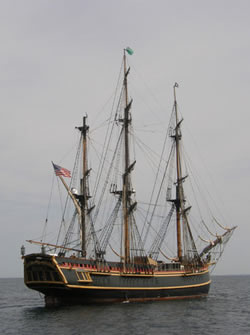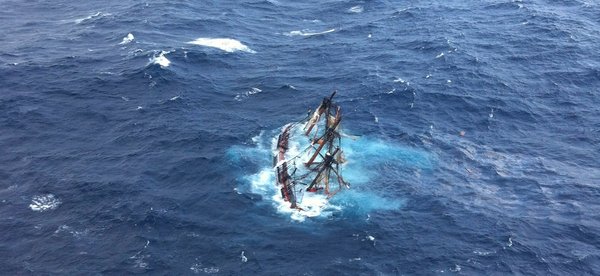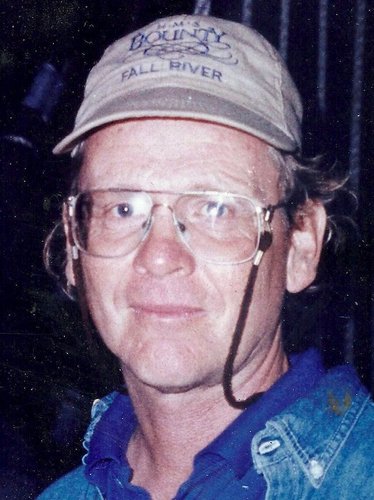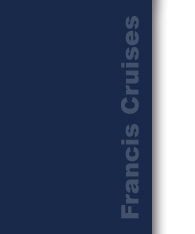 HMS Bounty Sinking
HMS Bounty Sinking
We saw the stately and beautiful HMS Bounty during our 2012 cruise in southern New England, when we took the picture shown at right. About 2 months later, Bounty was at the bottom of the Atlantic, a victim of Hurricane Sandy. Here's the story.
Evoking 18th-Century Drama, a Tragedy on the Bounty
The New York Times
Nov. 3, 2012
A fateful meeting of the maritime past and present began amid the Monday morning dread of Hurricane Sandy, when distressing word came from the murk of the roiling Atlantic: the captain and crew of the H.M.S. Bounty, a vessel of timber rigged to evoke 18th-century adventure, were abandoning ship.
Before long, a Coast Guard helicopter equipped with 21st-century search-and-rescue technology was hovering in the predawn dimness over a choppy disaster site, some 90 miles from shore. A life raft here. A life raft there. A man in a survival suit, floating like a red starfish. And the 115-foot main mast, jutting from the mostly submerged Bounty.
As the helicopter descended to begin its mission, its four-person crew could see the 30-foot waves of the coffee-black sea coming from all directions. “Like a washing machine,” recalled Randy Haba, 33, a Coast Guard rescue swimmer who grew up in a farming community outside landlocked Denver, and whose job was to leap into that rinse-cycle turbulence.

On Friday, the Coast Guard announced a formal investigation into this terrible adventure at sea, one filled with a dime novel’s blend of heroism and tragedy. Fourteen of the 15 crew members were rescued. The body of the 15th — a woman who claimed relation to the original Bounty’s leading mutineer, Fletcher Christian — was recovered. And on Thursday night, the Coast Guard reluctantly suspended its search for the longtime captain, Robin Walbridge, 63, who was said to consider the Bounty an extension of himself.
The Atlantic Ocean may have swallowed the ship and its captain, but floating on the surface remain many questions, especially: Why go to sea amid the constant reports of this storm’s particular wrath?
Grant Bredeson, 32, a former Bounty deckhand, is helping to collect donations for those affected through a PayPal account at tallshipbounty.org/online-store. He said that while he could not speak for his good friend Captain Walbridge, “I do know that Robin always thought a ship is better at sea in a storm like this,” considering the damage such a large vessel could incur and inflict while docked.
Then again, putting out to sea requires people, and the Bounty’s crew was a mix of veterans and novices.
Dan Moreland, the captain of another tall ship, the Picton Castle, told The Chronicle Herald of Nova Scotia that the approaching storm had persuaded him not to set sail. “It’s a huge system, and that made the decision very simple,” he said. Captain Moreland also said that while he knew Captain Walbridge to be an experienced seaman, he was shocked by his decision to sail. “Yes, I have to say yes, I can’t say anything else,” he said. “When I first heard the Bounty was out there, I thought, ‘You’ve got to be kidding.’ ” [Sam's note: We saw Picton Castle on our 2006 Windwards cruise; a gorgeous ship; see our photos.]
The Bounty was a tall-ship celebrity, built 50 years ago to promote the movie “Mutiny on the Bounty,” starring Marlon Brando. Since then, it has had an up-and-down career as a tourist attraction, restoration project, and occasional movie prop. It was also a working ship, used to educate people about seafaring and the 1789 mutiny against Lt. William Bligh.
 For the last 17 years, its captain had been Mr. Walbridge, described as a patient, soft-spoken mariner, the opposite of the domineering Bligh stereotype. “A really good man, kind, thoughtful, big-hearted, honest,” said Bert Rogers, the executive director of Tall Ships America, a nonprofit organization based in Newport, R.I.
For the last 17 years, its captain had been Mr. Walbridge, described as a patient, soft-spoken mariner, the opposite of the domineering Bligh stereotype. “A really good man, kind, thoughtful, big-hearted, honest,” said Bert Rogers, the executive director of Tall Ships America, a nonprofit organization based in Newport, R.I.
After a summer of festivals and sailing, the majestic Bounty was temporarily dry-docked for maintenance in Boothbay Harbor, Me. Often seen with other crew members, caulking seams and painting the hull, was Claudene Christian, 42, her long blond hair topped by a green BOUNTY cap.
Repairs done, the Bounty set sail two weeks ago for a brief stay in New London, Conn. Then, on Oct. 25, it set out for St. Petersburg, Fla., for a weekend tourism stop, after which it was to spend the winter in Galveston, Tex.
Supporters on Facebook wished it fair winds, though some questioned the wisdom of trying to skirt the approaching storm. This prompted someone from the H.M.S. Bounty Organization to post a message early Saturday afternoon, which read:
“Bounty’s current voyage is a calculated decision ... NOT AT ALL ... irresponsible or with a lack of foresight as some have suggested. The fact of the matter is ... A SHIP IS SAFER AT SEA THAN AT PORT!”
On Sunday morning, Captain Walbridge said in an e-mail to supporters that “we are just going to keep trying to go fast and squeeze by the storm and land as fast as we can.” But by 11 o’clock that night, one of its generators had failed and, as the organization’s Facebook page reported, the Bounty was “taking on more water than they would like.” Three hours later, these words appeared: “Your prayers are needed.”
Prompted by a worried call from the Bounty’s owner, who had lost communication with the ship, the Coast Guard in Elizabeth City, N.C., dispatched a search-and-rescue airplane to monitor the scene, about 90 miles southeast of Cape Hatteras and 160 miles west of the hurricane’s eye.
Sometime around 4 a.m., Captain Walbridge issued the order to abandon ship. According to Mr. Bredeson, the crew had often trained for this moment: grab the floating survival suits — often called “Gumby suits” and equipped with strobe lights — stored in a hatch, roll out and slip into the suit, help anyone needing assistance, and head to your assigned life raft, either the one on port side or the one on starboard.
By now another Coast Guard airplane had arrived to replace the first one on the scene and was soon followed by an MH-60 Jayhawk helicopter, piloted by Lt. Cmdr. Steve Cerveny and Lt. Jane Peña, and carrying Mr. Haba, the rescue swimmer, and Mike Lufkin, a hoist operator. In the dark sea below, they saw broken bits of brightness: the locator lights on the rafts and survival suits.
As the helicopter descended, Mr. Lufkin prepared to lower Mr. Haba into the watery vastness. They had trained for this many times, Mr. Lufkin said, but never in conditions quite so bad. The winds were strong, and the waves appeared to be right on top of them.
They focused first on the stray survivor Mr. Lufkin called “the free-floating gentleman.” Mr. Haba, still harnessed to the hoist, swam toward the man but was jerked back twice by the helicopter, all while he tried to go underneath each approaching swell. The third time was the charm. The survivor was “at that giving-up stage,” wide-eyed, lost, Mr. Haba recalled. The rescuer grabbed him, told him to relax, and secured him to the hoist.
“I got you,” he told the man.
Now it was on to other survivors, but not before the helicopter crew saw a brightness beckoning from the 11 o’clock position. An emergency light, attached to a mast of the foundering Bounty.

Soon Mr. Haba was swimming to one of the life rafts and identifying himself to the huddled survivors as, simply, the Coast Guard. Soon Mr. Lufkin was hoisting other Bounty crew members — two, three, four, five — into the Jayhawk. With fuel levels dropping, the Jayhawk then flew back to land, while another Coast Guard rescue crew picked up nine more people.
What Lieutenant Peña will remember is the sound she heard every time another survivor clambered, exhausted, into the helicopter. “They were cheering every time we picked up somebody new,” she said. The cheering did not last. Several hours later, another Coast Guard rescue team found Ms. Christian, alone and unresponsive. She would soon be declared dead.
She had lived in Alaska, California, and Oklahoma, attended the University of Southern California, and founded a cheerleader doll company. After joining the Bounty crew in the spring, she wrote on Facebook that Fletcher Christian would have been proud.
The search continued for Captain Walbridge. By airplane, helicopter, and cutter, the Coast Guard spent more than 90 hours scouring 12,000 square nautical miles for a single sea-loving man. But having failed, the Guard could only offer its thoughts and prayers, before moving on to another search, for answers.
Postscript
The following story was published in the Newark (NJ) Star-Ledger on February 11, 2014.
Report blames captain for sinking of ‘Bounty’
Hurricane Sandy destroyed tall ship off Carolina coast
Los AngeLes Times, Norfolk, VA — The body of Capt. Robin Walbridge, a stubborn and profane seaman who often said he feared no storm, was never found after the tall ship Bounty sank in the Atlantic Ocean after being pummeled by Hurricane Sandy on Oct. 29, 2012.
The ship’s sinking can now be laid at the feet of its dead captain. It was largely Walbridge’s fault that the ship was destroyed by the storm 110 miles off Cape Hatteras, NC, according to a National Transportation Safety Board investigation.
The NTSB conclusions, released yesterday, cited Walbridge, 63, a man with a lifetime of sailing experience, for his “reckless decision to sail the vessel into the well-forecasted path of Hurricane Sandy.”
Walbridge, who had bragged to a Maine TV station two months earlier that he “chased hurricanes,” exposed a leaky, poorly maintained craft — a replica of an 18th-century British Admiralty sailing ship — to deadly risks by ignoring pleas not to sail into the path of the approaching storm. He “subjected the aging vessel and the inexperienced crew to conditions from which the vessel could not recover,” investigators concluded.
Walbridge and Claudene Christian, 42, who had volunteered to become a $100/week deckhand, died in the sinking. Christian’s body was found 10 hours after the ship sank and about eight miles away, still in a protective immersion suit. Fourteen crew members survived, but three were seriously injured.
The 108-foot Bounty was built in 1960 for MGM Studios for the 1962 Marlon Brando movie “Mutiny on the Bounty.” The Bounty also appeared in one of the “Pirates of the Caribbean” movies.
It was being used as a Coast Guard-certified “moored attraction vessel,” visited dockside by tourists paying $10 each. A maritime document described it as a “wooden sailing ship of primitive build.” It wasn’t licensed to carry passengers at sea.
The Bounty left St. Petersburg, FL [Sam's note: actually, New London, CT] on Oct. 25, 2012, just as forecasters predicted a devastating hit by Hurricane Sandy as the storm lumbered up the Atlantic toward the East Coast. Despite pleas by crew members to stay safely in port, Walbridge set sail into the teeth of the storm and its forecast 100-mph winds.
Though the captain himself referred to Sandy as a “Frankenstorm,” he assured his crew that his sailing skills would guide the Bounty safely around the storm. Insisting that ships were safer in a storm than in port, Walbridge told his panicked crew that he would sail to Sandy’s southeast quadrant to take advantage of favorable winds that would blow the vessel to safety.
That decision was inexplicable and irresponsible, the investigation concluded.
“Although this wooden ship was modeled after an 18th-century vessel, the captain had access to 21st-century hurricane-modeling tools that predicted the path and severity of Hurricane Sandy,” NTSB Chairman Deborah A.P. Hersman said in a statement that accompanied the report. “The Bounty’s crew was put into an extraordinarily hazardous situation through decisions that by any measure didn’t prioritize safety.”
A U.S. Coast Guard and NTSB investigative hearing last February featured anguished testimony by crew members and maritime experts who described a compromised ship, a headstrong captain, an inexperienced crew, and slipshod maintenance of a vessel.
Testimony showed that Walbridge wanted to reach St. Petersburg because the ship was scheduled for an exhibit on Nov. 10, though he would still have arrived in time if he had left port after Sandy. The hearing also revealed that the Bounty was a money pit for owner Robert Hansen, who had formed HMS Bounty Organization to handle the ship’s affairs, but then put it up for sale.
The NTSB concluded the owner “did nothing to dissuade the captain from sailing into known severe weather conditions.” A lack of “effective safety oversight by the vessel organization contributed to the sinking.”
“The captain may have focused too narrowly on the position of the storm’s eye instead of on Sandy’s total wind expanse (winds associated with the storm spanned more than 1,000 miles),” the report said. “The captain seemed to believe he could outrace the storm.”


